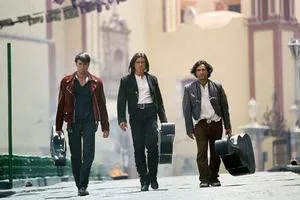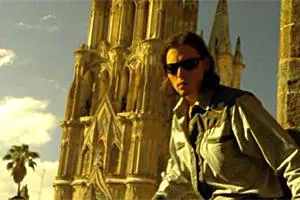
Once Upon a Time in Mexico: A Rodriguez Fantasy
The Mexican Revolution officially ended in 1917 with the triumph of capitalism. The last military revolt occurred in 1929, and the final general ascended to power peacefully in 1940, stepping down six years later. Corruption, narcotics, and political assassinations are practically national pastimes. Yet, Robert Rodriguez’s “Once Upon a Time in Mexico” is ultimately a flight of fancy.
While the unrestrained indulgence of cinematic imagination can be tiresome, if Rodriguez is what we have, then so be it. He possesses talent, operates on a reasonable budget, and seems a decent guy. Within a fairly standard revenge narrative, he manages to inject his own simple, homespun observations.

Genre-Bending Mayhem
Rodriguez, a successful businessman, family man, and public darling, is simply having fun. And what fun it is, with a complete genre collection of toys. There’s an anti-presidential conspiracy, an all-powerful drug cartel, a scheming CIA agent, a retired FBI operative, a sadistic general, the ever-enigmatic Antonio Banderas, and a couple of loyal sidekicks, including Enrique Iglesias as a perpetually inebriated character.
As clear as day, the drug cartel will pay the general to assassinate the president. The CIA, opposed to the cartel but in favor of the assassination, will pit Banderas against the general and the retired FBI agent against the drug lord. Chaos ensues, and ultimately, the “good guys” prevail.
This clarity allows for the development of distinct personalities. Salma Hayek is present, albeit primarily in flashbacks, which streamlines the plot. The CIA agent (Johnny Depp) is obsessed with Mexican pork. The FBI agent is tracking down a local Dr. Mengele. The drug lord (Willem Dafoe) takes piano lessons, frequently severing his instructors’ fingers. His henchman (Mickey Rourke) is fed up with Mexico and longs for home and his mother. Even a minor informant quips, “You wouldn’t kill me for ten bucks,” prompting Depp’s sardonic reply, “I would for ten bucks.”
The entire political-economic charade has become wearisome to everyone involved. This note of weary resignation resonates more powerfully than the plot itself.

Colorful Details and Practical Effects
Individuality breeds even more colorful details. When Johnny Depp’s eyes are gouged out, it’s done with a silver drill bit. When he shoots, he does so with a third hand – from beneath a prosthetic in a glove. When the guitar case is used as a weapon (as in “Desperado”), it functions as a flamethrower. And if there’s gunfire, it’s inevitably during the nationwide Day of the Dead celebration.
Banderas will answer for all of Mexico, swapping jackets with the president, who is also a musician (“El Mariachi”). Banderas will sport braid and a silk sash, as the noble avenger is the eternal, true president of all countries.
Hardly a frame lacks some embellishment, although Johnny Depp’s eyelessness is particularly striking. Rodriguez revels in the opportunity to construct real-world shots, working with actors in actual churches, palaces, and taverns, rather than on a green screen. He prefers shooting with conventional weaponry over laser cannons. With a modest budget of $29 million, he finds a beautiful traitor and dancers with impossibly long legs. He, too, longs for handcrafted imagination that demands contact with reality, not virtual reality.
